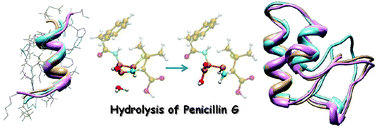Exploring the conformational and reactive dynamics of biomolecules in solution using an extended version of the glycine reactive force field†
Abstract
In order to describe possible reaction mechanisms involving

* Corresponding authors
a
CNR – Institute of Chemistry of Organometallic Compounds – UOS Pisa, Area della Ricerca, via G. Moruzzi 1, I-56124 Pisa, Italy
E-mail:
sapeptides@gmail.com
b Technical University of Denmark – Department of Chemistry, Kemitorvet, Kongens Lyngby, Denmark
c
Department of Mechanical and Nuclear Engineering, Pennsylvania State University, University Park, Pennsylvania 16802-1414, USA
E-mail:
klj174@psu.edu
d Department of Pharmaceutical Sciences, College of Pharmacy, Western University of Health Sciences, Pomona, California 91766-1854, USA
e Scuola Normale Superiore, piazza dei Cavalieri 7, I-56126 Pisa, Italy
In order to describe possible reaction mechanisms involving

 Please wait while we load your content...
Something went wrong. Try again?
Please wait while we load your content...
Something went wrong. Try again?
S. Monti, A. Corozzi, P. Fristrup, K. L. Joshi, Y. K. Shin, P. Oelschlaeger, A. C. T. van Duin and V. Barone, Phys. Chem. Chem. Phys., 2013, 15, 15062 DOI: 10.1039/C3CP51931G
To request permission to reproduce material from this article, please go to the Copyright Clearance Center request page.
If you are an author contributing to an RSC publication, you do not need to request permission provided correct acknowledgement is given.
If you are the author of this article, you do not need to request permission to reproduce figures and diagrams provided correct acknowledgement is given. If you want to reproduce the whole article in a third-party publication (excluding your thesis/dissertation for which permission is not required) please go to the Copyright Clearance Center request page.
Read more about how to correctly acknowledge RSC content.
 Fetching data from CrossRef.
Fetching data from CrossRef.
This may take some time to load.
Loading related content
